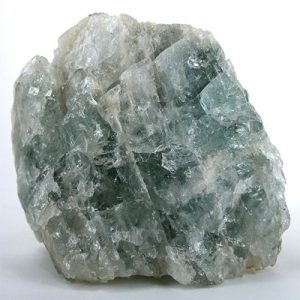Oligoclase (Feldspar)
Oligoclase is a somewhat rare variety of Albite and a member of the Plagioclase Feldspars of the Feldspar Group of minerals that includes Albite, Amazonite, Andesine, Anorthite, Bytownite, Hyalophane, Labradorite, Moonstone,Oligoclase, Orthoclase, Sanidine and Sunstone. The Plagioclase Feldspars form a series between Albite and Anorthite. Albite is the sodium-rich end member while Anorthite is the calcium-rich end member and Oligoclase is the intermediate member. Oligoclase is about 90-70% Albite and 10-30% Anorthite.
Oligoclase was named in 1826 by August Breithaupt from the Greek words όλίγος and κλάσις meaning little and to break because the mineral was thought to have a less perfect cleavage than Albite. It had previously been recognized as a distinct species by J. J. Berzelius in 1824. He named it Soda-Spodumene (Natron-Spodumen) because of its resemblance in appearance to Spodumene.
Oligoclase is found as colorless to pale yellow or pale green, and rarely blue, crystals in only a few locations around the world. Colorless, transparent crystals have been found at the Hawk Mine, Bakersville, North Carolina and occasionally faceted as gems. “Confetti” Sunstone, from Arusha, Tanzania is a variety of Oligoclase with a colorless, yellow, orange or light green background and containing reddish metallic flashes, due to the presence of many small red plateletes of Hematite oriented within the Feldspar structure. A similar type of Sunstone has been found at Coimbatore, Tamil Nadu State, India. A bright blue Oligoclase has rarely been available from Madawaska, Bancroft District, Hastings County, Ontario, Canada.
Oligoclase distribution: A widespread mineral. Fine material from Danviken, near Stockholm, Sweden. At Arendal, on Tromöy Island at Alve, Tvedestrand, and elsewhere in Norway. In Sweden, at Ytterby. From Kemiö (Kimito) Island, Finland. At Silberberg, near Bodenmais, Bavaria, Germany. On Tenerife, Canary Islands. In the USA, at Fine and Macomb, St. Lawrence County, New York; on Corundum Hill, Chester County, and at Media, Delaware County, Pennsylvania; near Hawk, east of Bakersville, Mitchell County, North Carolina. At Lake Harbour, Baffin Island, Northwest Territories, Canada.

| Chemical Formula: | (Na,Ca)[Al(Si,Al)Si2O8] |
| Sodium Calcium Aluminum Silicate | |
| Molecular Weight: | 263.02 gm |
| Composition: | Sodium | 8.30 % | Na | 11.19 % | Na2O |
| Calcium | 0.76 % | Ca | 1.07 % | CaO | |
| Aluminum | 10.77 % | Al | 20.35 % | Al2O3 | |
| Silicon | 31.50 % | Si | 67.39 % | SiO2 | |
| Oxygen | 48.66 % | O | |||
| 100.00 % | 100.00 % | = TOTAL OXIDE | |||
| Crystallography: | Triclinic – Pinacoidal |
| Crystal Habit: | Crystals uncommon, flattened and tabular along [010], to 6 cm; more commonly cleavable to compact, massive. |
| Twinning: | Typically twinned according to the Albite, Carlsbad, and Pericline laws. |
| Cleavage: | Perfect on {001}, less perfect on {010}, imperfect on {110}, (001) ^ (010) ~94º |
| Fracture: | Irregular/Uneven, Sub-Conchoidal, Step-Like |
| Tenacity: | Brittle |
| Moh’s Hardness: | 6.0 – 6.5 |
| Density: | 2.63 – 2.66 (g/cm3) |
| Luminescence: | Not usually fluorescent; may fluoresce faint red to faint white in SW UV |
| Radioactivity: | Not Radioactive |
| Color: | Colorless, white, pale greenish, blue; may be tinted gray, green or red due to inclusions; colorless in thin section; may be opalescent or iridescent |
| Transparency: | Transparent to translucent |
| Luster: | Vitreous to pearly |
| Refractive Index: | 1.533 – 1.552 Biaxial ( + ) or ( – ) |
| Birefringence: | 0.008 – 0.009 |
| Dispersion: | Weak; r > v |
| Pleochroism: | n/a |

